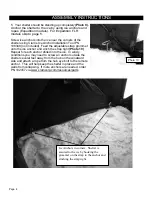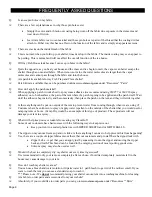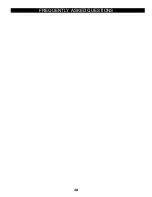
9
Q:
I can see pin holes in my fabric:
A:
There are a few explanations as to why those pin holes exist.
Simply the color and/or black-out coating being worn off the fabric due exposure in the elements and
wear due to friction.
Ice Armor fabric is a woven material and these pin holes are parts of the thread that the coating did not
attach to. Either way this has no effect on the function of the fabric and is simply an appearance issue.
Q:
There are cracks on the inside finish of the fabric:
A:
This is normal, when you fold up your shelter, lines develop in the fabric. The inside coating may even appear to
be peeling. This is normal and will not affect the overall function of the ice house.
Q:
Will my Fish House leak because I can see pin holes in the fabric?
A:
Quite the opposite, as you heat your house and the snow and ice begin to melt, the vapors can better escape the
shelter through an uncoated fabric. When it snows or rains, the water molecules are larger than the vapor
molecules and cannot pass through the fabric and into the house.
Q:
Are patch kits available for my Fish Trap and Clam shelter?
A:
Patch kits are available they can be purchased online www.clamcorp.com under “Resources” “Parts”
Q:
How do I apply the patch material?
A:
When applying a patch it works best to spray some adhesive (we recommend using 3M #77 or 3M #90 spray
adhesive) on to both surfaces; the part of the tent where the patch is going to be applied and the patch itself. Wait
until the adhesive begins to dry and becomes tacky, then place the patch on the tent, and they will stick together.
Q:
Is there anything can be put on outside of the tent to prevent water from coming through, when we are using it?
A:
Customers have been known to spray or apply water repellant on the outside of the shelter that you would use for
camping tents or boots. (Camp Dry would be an example of this type of product). These products will not
damage your tent in anyway.
Q:
What will help keep mice or rodents from eating my Clam Hub?
A:
Some of our customers have had success with the following ways to keep mice out.
Keep your tent in a sealed plastic tote with DRYER SHEETS and or MOTH BALLS
Q:
The zipper on my canvas freezes up and or sticks; is there anything I can use to help prevent this from happening?
A:
Yes, there are a couple of zipper lubricants out there that our customers and pro staff have had good luck with.
Zipper Lube - A gel that you can apply just by squeezing it onto the zipper and moving the zipper
back and forth. This brand can be found in the camping section of most sporting goods store.
Silicone spray may also be used as well.
Q:
Would it be best to completely dry my shelter out every time it gets used?
A:
It is recommended to dry your tent out completely after each use, if not dried completely moisture left in the
house may cause damage to your tent.
Q:
How do I wash my shelters canvas?
A:
You can use a bleach and water solution (10 parts water to 1 part bleach) to get rid of the mildew smell. If you
want to wash the tent you can use a standard soap to wash it.
*** Please note - We
do not
recommend placing your shelter canvas/tent into a washing machine for cleaning.
Q:
Am I able to order parts and accessories from your website?
A:
Absolutely, if you would like to order parts you can go to www.clamcorp.com under “Resources” “Parts”
FREQUENTLY ASKED QUESTIONS
Page 9
Summary of Contents for 108396
Page 10: ...10 FREQUENTLY ASKED QUESTIONS...




























